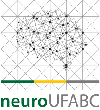Banca de DEFESA: ALESSANDRA APARECIDA MARQUES
Uma banca de DEFESA de MESTRADO foi cadastrada pelo programa.STUDENT : ALESSANDRA APARECIDA MARQUES
DATE: 06/06/2023
TIME: 14:00
LOCAL: Campus São Bernardo do Campo
TITLE:
Relationship between behavioral parameters and the expression of glucose transporters in a model of schizophrenia
PAGES: 65
BIG AREA: Ciências Biológicas
AREA: Fisiologia
SUBÁREA: Fisiologia de Órgãos e Sistemas
SPECIALTY: Neurofisiologia
SUMMARY:
Schizophrenia is a chronic and highly debilitating neuropsychiatric disorder that affects approximately 1% of the population. The available pharmacological treatments are not effective for all patients due to the heterogeneity of symptoms and still cause uncomfortable side effects. Therefore, it is essential to develop experimental models for the study of the pathophysiological mechanisms of this disorder. Although several hypotheses have been proposed to explain the symptoms of this disorder, its etiology is complex and still unknown. In this sense, disorders in glutamatergic neurotransmission due to hypofunction of the NMDA (N-methyl-D-aspartate) receptor have been proposed as one of the causes of the pathophysiology of the disease. Thus, the administration of ketamine, an NMDA receptor antagonist, is used to mimic behavioral and neurophysiological alterations similar to those found in patients with schizophrenia. However, the vast majority of studies using ketamine use acute treatment in adult animals, and the animals are tested immediately after the drug injection. In this context, the effects of chronic and long-term ketamine treatment during adolescence are scarce. In order to investigate this conjecture, the present work focused on developing a pharmacological paradigm as a predictive model for the study of schizophrenia through chronic administration of ketamine in adolescence. The results showed that chronic treatment with ketamine was able to mimic positive, negative, and cognitive symptoms. In addition, alterations in glucose transporters were observed in the hippocampus, indicating possible bioenergetic abnormalities in this model. These data, together, suggest that ketamine administered chronically in adolescence causes lasting alterations in the central nervous system and mimics positive, negative, cognitive, and bioenergetic symptoms observed in schizophrenia.
COMMITTEE MEMBERS:
Presidente - Interno ao Programa - 1887027 - FERNANDO AUGUSTO DE OLIVEIRA RIBEIRO
Membro Titular - Examinador(a) Interno ao Programa - 1994696 - SILVIA HONDA TAKADA
Membro Titular - Examinador(a) Externo à Instituição - SUZETE MARIA CERUTTI - UNIFESP
Membro Suplente - Examinador(a) Interno ao Programa - 1872537 - MARCELA BERMUDEZ ECHEVERRY
Membro Suplente - Examinador(a) Externo à Instituição - APARECIDA EMIKO HIRATA - UNIFESP




